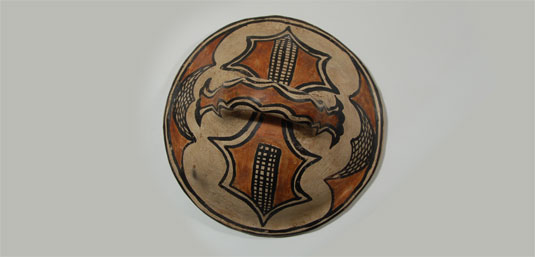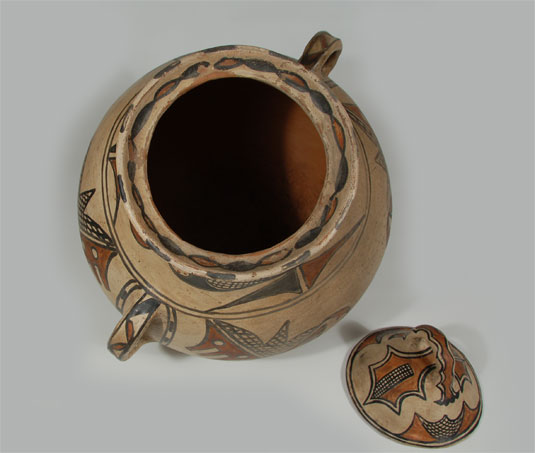San Ildefonso Pueblo Polychrome Lidded Jar [SOLD]
+ Add to my watchlist Forward to Friend
- Category: Historic
- Origin: San Ildefonso Pueblo, Po-woh-ge-oweenge
- Medium: clay, pigment
- Size: 18” height x 17-3/8” width
(base to lid top and handle to handle) - Item # C3675Z SOLD

It is known that Maria and Julian Martinez, after their marriage in 1904, became known as the best pottery couple in the pueblo, but this might not have happened had another couple from San Ildefonso not moved to Cochiti Pueblo in 1905. That couple, Martina Vigil Montoya (1856-1916) and her husband Florentino Montoya (1858-1918), were the finest potters from there from as early as the 1880s. They were masters at creating magnificent Polychrome jars. Martina had learned pottery making from her mother, Toña Peña Vigil, who also was a very talented potter. Florentino had studied the designs of Toña’s pottery and adapted his style on hers.
Martina and Florentino were the first potters to bring attention to San Ildefonso as a center of innovative ceramic genius. While potters of other pueblos had succumbed to making insignificant trinkets for the influx of tourists visiting New Mexico on the newly arrived rail service, San Ildefonso was spared this temptation because of its relative isolation. Martina and Florentino proceeded to produce magnificent wares. Their imaginative and inspirational courage was not recognized at the time but they set the stage for the future of pueblo ceramics. Martina passed this experimental quality on to her apprentice, Maria Martinez, who learned enthusiastically. Maria and Julian then carried it forward into the 20th century.
Attributing work to long-deceased artists is always subject to questions, but sometimes the work just seems to fit the hands of certain artists and it is not wrong to speculate that it was made by them. That is the case with this San Ildefonso lidded jar. It has construction and design elements that have been associated with Martina and Florentino.
Martina’s mother was from San Ildefonso and her dad from Cochiti so Martina was expected to share her loyalty to both. She and Florentino traveled to Cochiti on many occasions and it was during these trips that she discovered that the cream slip being used at Cochiti required only rag polishing while that at San Ildefonso required extensive stone polishing. She introduced the Cochiti slip at San Ildefonso before her departure in 1905.
Martina and Florentino made a permanent move to Cochiti in 1905. Martina began using Cochiti clay and slip but their pottery retained its San Ildefonso character. Martina continued making the same vessel shapes with which she was familiar and Florentino painted in the same style. No other potters at San Ildefonso made large jars of their style. All jars of this style and design in collections are attributed to Martina and Florentino as no other artists are recognized for making such. The painted design on this jar is none other than the work of Florentino. Elements of this design are seen on other pottery known to have been painted by him.
Jonathan Batkin, currently director of the Wheelwright Museum in Santa Fe, wrote an article entitled Martina Vigil and Florentino Montoya: Master Potters of San Ildefonso and Cochiti Pueblos, which was published in American Indian Art Magazine in the Autumn 1987 issue. It is an article that brings attention to these talented two individuals and discusses how important they were to the survival of pueblo pottery production in the 20th century.
It is pottery of the caliber of this jar that will be recognized someday as the true national treasure that it is. There is very little Indigenous art available today of the caliber of this which is available for purchase by collectors.
Condition: I checked the jar out with UV long-wave and short-wave light and found that there was a hairline crack on the lid that has been repaired and on one of the jar handles. It does not appear to be anything serious.
Recommended Reading: Batkin, Jonathan. Martina Vigil and Florentino Montoya: Master Potters of San Ildefonso and Cochiti Pueblos. American Indian Art Magazine, Autumn 1987.
Batkin, Jonathan. Pottery of the Pueblos of New Mexico 1700-1940. The Taylor Museum
Provenance: This jar originated from Ancho, New Mexico (now a ghost town) 23 miles north of Carrizozo, New Mexico (Southwest New Mexico). Carrizozo is the Lincoln County, NM seat.
Ancho was first settled at the turn of the 20th Century in part by a large family by the name of Straley, homesteading there from Sterling City, Texas, by way of covered wagons, contingent on building a family ranching business. The area was fertile ground for both farming and ranching and sits adjacent to the Union Pacific Railroad (historically the Southern Pacific Railroad).
In 1902 gypsum was discovered and a settler named Bosque from Iowa saw potential and established the Ancho Brick Company, a brick manufacturing company there in 1905.
In 1906 the San Francisco earthquake created a boon for brick manufacturing at Ancho in that the Ancho Brick's product could be readily shipped by rail via the Depot there directly to San Francisco.
Grandma Jackie Silvers Straley "Jackie," having previously owned and operated a Dry Goods and Grocery in Sterling City, Texas, opened a similar business in Ancho and also operated the Ancho Post Office. In all there were nine Straley children who worked the family ranch. Many family members over time would work at both the ranch and serve as Post Masters. One sibling, Harry, who was about 15 years old when they moved from Texas would go on to serve as a local law enforcement officer and eventually served as the Lincoln County Democratic Representative for the State of New Mexico. Harry was very outgoing and although not a big man was known as "Big Chief Straley." He was also a collector of all things Native American and of interest relative to the West.
Due to the San Francisco earthquake, Ancho Brick prospered and was soon sold to Phelps Dodge Corp which invested $150,000 in building many new kilns, but in the end it was not profitable and went bankrupt in 1921.
In 1954, Highway 54 was moved 2-1/2 miles and bypassed Ancho and in 1959 the Depot closed.
Shortly thereafter the Straley family purchased the depot and Harry and his mother Sarah Jackson Silvers Straley turned it into a museum called “My House of Old Things." This is where Harry "Big Chief Straley" housed many of his collected objects, one of which was a large, lidded and handled San Ildefonso storage jar he'd collected "up north" in about 1915-18 as best as can be recollected by family members still living in the Ancho area today.
By way of Grandma Jackie's inspiration to continue her dream of preserving their family heritage and Ancho's history, her daughter Sarah Jackson Silvers Straley, along with others, founded the Carrizozo Historical Society and Museum in Carrizozo. Today's remaining two family members have donated the original covered wagons on which the family arrived to New Mexico along with an original ranch cabin and other materials. The family member from which the San Ildefonso storage jar came has also committed to donate the Depot and another family cabin which are to be moved about 25 miles north to Carrizozo. The remaining family still retains ownership of the Ancho town and family Cemetery, having restored and conserved it over the years. Both New Mexico and family heritage are important to the family today. Proceeds of the sale of the jar have been dedicated to the continued interest of sustaining family ranch projects.

- Category: Historic
- Origin: San Ildefonso Pueblo, Po-woh-ge-oweenge
- Medium: clay, pigment
- Size: 18” height x 17-3/8” width
(base to lid top and handle to handle) - Item # C3675Z SOLD
Adobe Gallery Recommended Reading
Adobe Gallery Recommended Items
If you are interested in this item, we would also like to recommend these other related items:



